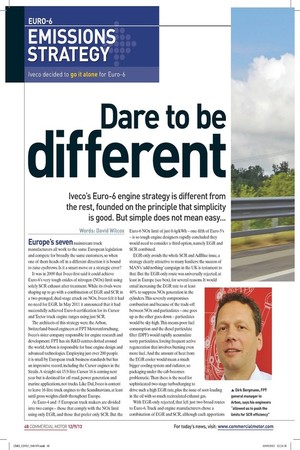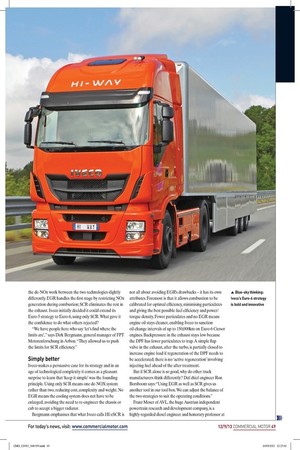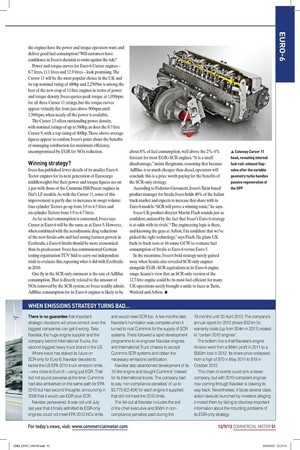EURO-6
Page 33

Page 34

Page 35

Page 36

If you've noticed an error in this article please click here to report it so we can fix it.
EMISSIONS STRATEGY
Iveco decided to go it alone for Euro-6
Dare to be different
lveco's Euro-6 engine strategy is different from the rest, founded on the principle that simplicity is good. But simple does not mean easy... Words: David Wilcox
Europe's seven mainstream truck manufacturers all work to the same European legislation and compete for broadly the same customers, so when one of them heads off in a different direction it is bound to raise eyebrows. Is it a smart move or a strategic error?
It was in 2009 that Iveco first said it could achieve Euro-6's very tough oxides of nitrogen (NOx) limit using solely SCR exhaust after-treatment. While its rivals were shaping up to go with a combination of EGR and SCR in a two-pronged, dual-stage attack on NOx, Iveco felt it had no need for EGR. In May 2011 it announced that it had successfully achieved Euro-6 certification for its Cursor and Tector truck engine ranges using just SCR.
The architects of this strategy were the Arbon, Switzerland-based engineers at FPT Motorenforschung, Iveco's sister company responsible for engine research and development. FPT has six R&D centres dotted around the world; Arbon is responsible for base engine design and advanced technologies. Employing just over 200 people it is small by European truck business standards but has an impressive record, including the Cursor engines in the Stralis. A straight-six 15.9-litre Cursor 16 is coming next year but is destined for off-road, power generation and marine applications, not trucks. Like Daf, Iveco is content to leave 16-litre truck engines to the Scandinavians, at least until gross weights climb throughout Europe. At Euro-4 and -5 European truck makers are divided into two camps — those that comply with the NOx limit using only EGR, and those that prefer only SCR. But the
Euro-6 NOx limit of just 0.4g/kWh — one-fifth of Euro-5's — is so tough engine designers rapidly concluded they would need to consider a third option, namely EGR and SCR combined. EGR-only avoids the whole SCR and AdBlue issue, a strategy clearly attractive to many hauliers: the success of MAN's 'add nothing' campaign in the UK is testament to that. But the EGR-only route was universally rejected, at least in Europe (see box), for several reasons. It would entail increasing the EGR rate to at least 40% to suppress NOx generation in the cylinders. This severely compromises combustion and because of the trade-off between NOx and particulates — one goes up as the other goes down — particulates would be sky-high This means poor fuel consumption and the diesel particulate filter (DPF) would rapidly accumulate sooty particulates, forcing frequent active regeneration that involves burning even more fuel. And the amount of heat from the EGR cooler would mean a much bigger cooling system and radiator, so packaging under the cab becomes problematic. Then there is the need for sophisticated two-stage turbocharging to
drive such a high EGR rate, plus the issue of soot-loading in the oil with so much recirculated exhaust gas. With EGR-only rejected, that left just two broad routes to Euro-6. Truck and engine manufacturers chose a combination of EGR and SCR, although each apportions
the de-NOx work between the two technologies slightly differently. EGR handles the first stage by restricting NOx generation during combustion; SCR eliminates the rest in the exhaust. Iveco initially decided it could extend its Euro-5 strategy to Euro-6, using only SCR. What gave it the confidence to do what others rejected?
"We have people here who say 'let's find where the limits are'," says Dirk Bergmann, general manager of FPT Motorenforschung in Arbon. "They allowed us to push the limits for SCR efficiency."
Simply better
Iveco makes a persuasive case for its strategy and in an age of technological complexity it comes as a pleasant surprise to learn that 'keep it simple' was the founding principle. Using only SCR means one de-NOX system rather than two, reducing cost, complexity and weight. No EGR means the cooling system does not have to be enlarged, avoiding the need to re-engineer the chassis or cab to accept a bigger radiator. Bergmann emphasises that what Iveco calls HI-eSCR is
not all about avoiding EGRs drawbacks — it has its own attributes. Foremost is that it allows combustion to be calibrated for optimal efficiency, minimising particulates and giving the best possible fuel efficiency and power/ torque density. Fewer particulates and no EGR means engine oil stays cleaner, enabling Iveco to sanction oil-change intervals of up to 150,000km on Euro-6 Cursor engines. Backpressure in the exhaust stays low because the DPF has fewer particulates to trap. A simple flap valve in the exhaust, after the turbo, is partially closed to increase engine load if regeneration of the DPF needs to be accelerated; there is no 'active regeneration' involving injecting fuel ahead of the after-treatment.
But if SCR alone is so good, why do other truck manufacturers think differently? Daf chief engineer Ron Borsboom says: "Using EGR as well as SCR gives us another tool in our tool box. We can adjust the balance of the two strategies to suit the operating conditions." Franz Moser of AVL, the huge Austrian independent powertrain research and development company, is a highly-regarded diesel engineer and honorary professor at
Vienna Technical University. He describes the SCR-only approach to Euro-6 as high risk. More specifically, Moser notes the challenge of managing SCR so that it works sufficiently well at low-temperature, low-load conditions.
The cold facts
Moser's apprehension about SCR in these circumstances is well-founded. Studies by Austria's Graz Technical University show that at low road speeds, such as on urban deliveries, NOx emissions from Euro-5 SCR trucks are similar to those of Euro-3 trucks in the same circumstances. This is despite Euro-5's NOx limit being far lower (2g/kWh) than Euro-3's (5g/kWh). Engine loads at low speed are so low exhausts remain cool. SCR systems are at their worst because catalysts perform poorly at low temperatures and AdBlue struggles to atomise in the exhaust gas, so AdBlue dosing cannot start until the exhaust temperature is approaching 200C. These are the conditions that make the EGR and SCR combination look most attractive. The management system turns down AdBlue dosing and opens the EGR valve, allowing EGR to take over NOx reduction duties. Poor fuel consumption and high particulate emissions are the price paid, but only until exhaust
temperature is back within a more normal operating range, allowing SCR to take over. The challenge facing Iveco was to cut engine-out NOx emissions of around 7g/kWh to Euro-6's 0.4g/kWh on the World Harmonised Steady-state Cycle (WHSC) by the time they get to the truck's tailpipe. This means 95% of NOx must be removed, despite the inclusion of lowtemperature and low-load conditions in Euro-6 test cycles. Delaying AdBlue injection until the exhaust is warm makes it very difficult to achieve
95% NOx removal across the whole cycle.
Dirk Bergmann explains that FPT has particular expertise in SCR, evidenced by the "urea room" at Arbon, devoted to honing AdBlue injection and mixing. Bergmann says the key is not the hardware, but the control strategy. "We are using a model-based approach for our urea dosing, which we have patented," he says.
Data from the engine management system and NOx and temperature sensors in the after-treatment box is fed into algorithms written by Iveco and used to control AdBlue dosing. "The algorithms calculate the amount of ammonia stored on the SCR catalysts," says Bergmann The ammonia, derived from the chemical reaction of AdBlue and exhaust gas, is what eliminates NOx in the SCR catalyst. In a nutshell, Iveco believes it has more precise, proactive control of AdBlue dosing than the competition.
Bergmann claims Iveco's SCR performance is also enhanced by a patented method of creating turbulence in the SCR mixing pipe, assisting AdBlue atomisation in the exhaust stream. Perhaps one of the most appealing aspects of Iveco's
strategy concerns the need to keep after-treatment systems warm so they perform well. NOx is generated at the very highest temperatures during combustion, so EGR works by reducing the oxygen content in the cylinders, lowering the combustion gas temperature and thus limiting NOx. Bergmann says lowering exhaust gas temperature conflicts with the need to bring after-treatment catalysts up to temperature as quickly as possible.
"But we do not suppress combustion temperature," he says, "because a high temperature gives efficient combustion." It follows that exhaust gas in SCR-only engines is hotter to get the after-treatment system up to peak efficiency. "It means we can get SCR working more quickly than most," concludes Bergmann. Achieving type approval for Euro-6 Cursor and Tector engines proves Iveco's SCR-only strategy is technically viable. Will it prove the right decision in the long run? Will
the engines have the power and torque operators want, and deliver good fuel consumption? Will customers have confidence in Iveco's decision to swim against the tide?
Power and torque curves for Euro-6 Cursor engines — 8.7 litres, 11.1 litres and 12.9 litres — look promising. The Cursor 11 will be the most popular choice in the UK and its top nominal rating of 480hp and 2,250Nm is among the best of the new crop of 11-litre engines in terms of power and torque density. Iveco quotes peak torque at 1,050rpm for all three Cursor 11 ratings, but the torque curves appear virtually flat from just above 900rpm until 1,500rpm, when nearly all the power is available.
The Cursor 13 offers outstanding power density, with nominal ratings of up to 560hp, as does the 8.7-litre Cursor 9, with a top rating of 400hp. These above-average figures appear to confirm Iveco's point about the benefits of managing combustion for maximum efficiency, uncompromised by EGR for NOx reduction.
Winning strategy?
Iveco has published fewer details of its smaller Euro-6 Tector engines for its next generation of Eurocargo middleweights but their power and torque figures are on a par with those of the Cummins ISB/Paccar engines in Daf's LF models. As with the Cursor 11, some of this improvement is partly due to increases in swept volume: four-cylinder Tectors go up from 3.9 to 4.5 litres and six-cylinder Tectors from 5.9 to 6.7 litres.
As far as fuel consumption is concerned, Iveco says Cursor at Euro-6 will be the same as at Euro-5. However, when combined with the aerodynamic drag reductions of the new Stralis cabs and fuel-saving features proven in EcoStralis, a Euro-6 Stralis should be more economical than its predecessor. Iveco has commissioned German testing organisation TIN Sild to carry out independent trials to evaluate this, repeating what it did with EcoStralis in 2010. One fly in the SCR-only ointment is the rate of AdBlue consumption. That is directly related to the amount of NOx removed by the SCR system, so Iveco readily admits AdBlue consumption for its Euro-6 engines is likely to be
about 8% of fuel consumption, well above the 2%-4% forecast for most EGR+SCR engines. "It is a small disadvantage," insists Bergmann, reasoning that because AdBlue is so much cheaper than diesel, operators will conclude this is a price worth paying for the benefits of the SCR-only strategy.
According to Federico Giovanetti, Iveco's Turin-based product manager for Stralis, Iveco holds 40% of the Italian truck market and expects to increase that share with its Euro-6 models. "SCR will prove a winning route," he says.
Iveco UK product director Martin Flach sounds just as confident, unfazed by the fact that Iveco's Euro-6 strategy is at odds with its rivals: "The engineering logic is there, and knowing the guys at Arbon, I'm confident that we've picked the right technology," says Flach. He plans UK back-to-back tests at 44-tonne GCVV to evaluate fuel consumption of Stralis at Euro-6 versus Euro-5. In the meantime, Iveco's bold strategy surely gained sway when Scania also revealed SCR-only engines alongside EGR+SCR equivalents in its Euro-6 engine range. Scania's view that an SCR-only version of the 12.7-litre engine could be its most fuel-efficient for many UK operations surely brought a smile to faces in Turin, Watford and Arbon. •









































